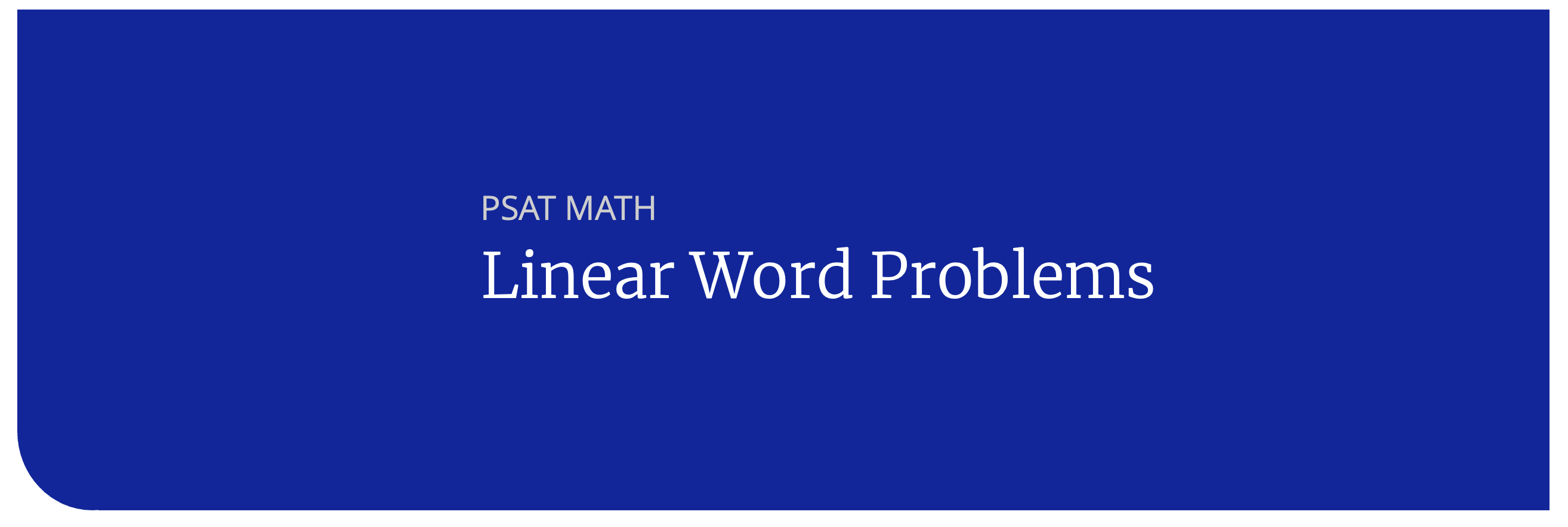PSAT Math: Linear Word Problems
On the PSAT Math Test, another way linear equations can be made to look complicated is for them to be disguised in “real-world” word problems, where it’s up to you to extract and solve an equation. When you’re solving these PSAT math problems, you may run into trouble translating English into math. The following table shows some of the most common phrases and mathematical equivalents you’re likely to see on the PSAT.
PSAT Word Problems Translation Table
| English | Math |
| equals, is, equivalent to, was, will be, has, costs, adds up to, the same as, as much as | = |
| times, of, multiplied by, product of, twice, double, by | × |
| divided by, per, out of, each, ratio | ÷ |
| plus, added to, and, sum, combined, total, increased by | + |
| minus, subtracted from, smaller than, less than, fewer, decreased by, difference between | – |
| a number, how much, how many, what | x, n, etc. |
Linear word problems are made more difficult by complex phrasing and extraneous information. Don’t get frustrated—word problems can be broken down in predictable ways.
To stay organized on Test Day, use the Kaplan Strategy for Translating English into Math:
- Define any variables, choosing letters that make sense.
- Break sentences into short phrases.
- Translate each phrase into a mathematical expression.
- Put the expressions together to form an equation.
Let’s apply this to a straightforward example: Colin’s age is three less than twice Jim’s age.
- Define any variables, choosing letters that make sense: We’ll choose C for Colin’s age and J for Jim’s age.
- Break sentences into short phrases: The information about Colin and the information about Jim seem like separate phrases.
- Translate each phrase into a mathematical expression: Colin’s age = C; 3 less than twice Jim’s age = 2J – 3.
- Put the expressions together to form an equation: Combine the results to get C = 2J – 3.
This strategy fits into the larger framework of the Kaplan Method for Math: When you get to Step 2: Choose the best strategy to answer the question and are trying to solve a word problem as efficiently as possible, switch over to this strategy to move forward quickly.
PSAT Practice Question: Linear Word Problems
The Kaplan Strategy for Translating English into Math works every time. Apply it here to a test-like example:
When translating from English to math, start by defining the variables, choosing letters that make sense. Then, break the question down into small pieces, writing down the translation for one phrase at a time.
Explanation:
The phrase “how many visits” indicates an unknown, so you need a variable. Use an intuitive letter to represent the number of visits; call it v. The question asks when the two memberships will cost the “same amount,” so write an equation that sets the total membership costs equal to each other.
Package A costs $325 for unlimited visits, so write 325 on one side of the equal sign. Package B costs $4 per visit (not including, or except for, the first 5 visits), or 4(v − 5), plus a flat $185 enrollment fee, so write 4(v − 5) + 185 on the other side of the equal sign. That’s it! Now, solve for v:
325 = 4(v − 5) + 185
140 = 4v − 20
160 = 4v
40 = v
The answer is (C).
On PSAT Test Day
PSAT word problems test your understanding of how to describe real-world situations using math equations. For some questions, it will be up to you to extract and solve an equation; for others, you’ll have to interpret an equation in a real-world context.
< Previous: PSAT Math Practice: Linear Equations
Next: PSAT Math: Linear Graphs >

